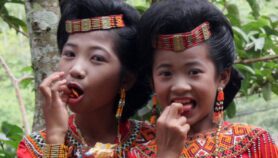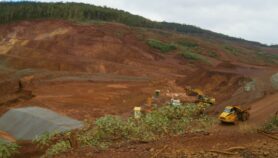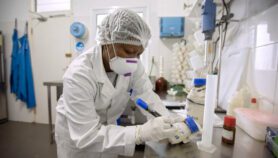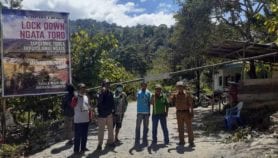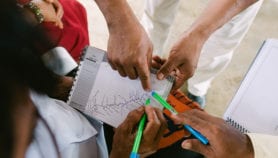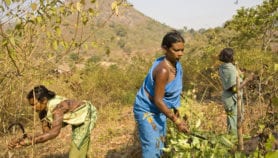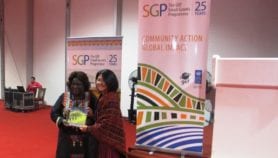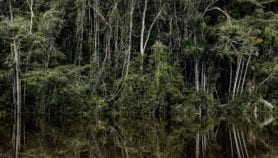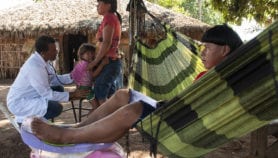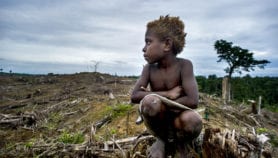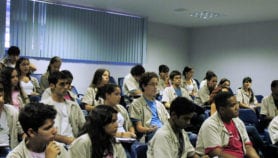Send to a friend
The details you provide on this page will not be used to send unsolicited email, and will not be sold to a 3rd party. See privacy policy.
Anuradha Alahakoon reports from rural Sri Lanka on how simple, effective science has boosted traditional methods of harvesting sap from ‘treacle trees’.
It is midday, but the mountain air is cool. I am in the village of Rogesen Gama in central Sri Lanka, nearly a kilometre above the sea level and in the midst of a mountain wilderness. As I gaze at the tall kithul palm in front of me, one of the villagers explains why its sap is so important to him.
 |
| A kithul tree with a hanging flower cluster or ‘mala’ |
The kithul tree (Caryota urens) is a palm that grows up to 20 metres high and produces large hanging clusters of flowers near the top. Tappers like Kumara are the heirs of a 2000-year tradition, braving the ascent twice daily to extract the sap.
They do this by first gashing the base of the flower-cluster stalk, called a mala, then applying a herbal mixture to the ‘wound’ to stimulate it to excrete sap. This prevents the flower from maturing so quickly, since mature flowers cannot be used for harvesting.
After about two days, the mala is ready. The tapper ties together the hanging flowers, and cuts off their ends, positioning a clay pot beneath to collect the dripping sap. The pot is replaced twice a day.
 |
| Cutting the ends of the tied flower to extract the sap |
Kithul sap is used to make treacle and a hardened solid version of it known as jaggery. Both are then sold at local markets. “Sometimes we sell the sap itself,” says Kumara. The sap is also used to make a local alcoholic drink.
The treacle was highly valued by Sri Lanka’s ancient monarchy. Sap from the region near Rogesen Gama is of especially high quality, so the villagers say the old kings are blessing them from their graves.
And now people in Rogesen Gama say they have another blessing, this time from modern science.
Science for treacle
In 1994, the Sri Lankan government — which had paid little attention to this traditional craft before — stepped in through its Ministry of Rural Development and Self Employment Generation to fund research aiming to make sap extraction more productive.
“They introduced a new reagent to treat the mala,” explains Ariyawansa Premadasa, who has been a tapper for over 50 years. “We began to use this instead of our traditional herbal mixture. I can get sap from unproductive mala. Now I extract two to three bottles more from each one.”
After analysing the traditional herbal mixture, the research team headed by Sirimal Premakumara from the Colombo-based Industrial Technology Institute came up with a new mixture.
This more than doubles the sap production of each flower cluster. It can raise the proportion of productive trees from 20-30 per cent using the traditional herbal mixture to nearly 100 per cent using the new product.
The invention won the country’s national science and technology award in November 2005, under the category of ‘production of raw materials for industry’. That same month it also received the Best Innovative Technology Award at the Industrial and Technology Institute’s 50th anniversary ceremony.
According to Premakumara, the reagent is made of plant regulators and food additives, including common additives such as salt. His team called the non-toxic mixture KASPER — which stands for Kithul Activation and Sap Production Enhancing Reagent — and has now submitted it for patenting.
Going national
The villagers happily accepted the new treatment, but the awards also focused attention on the traditional craft of tapping. This year, the Sri Lankan Export Development Board plans to develop kithul treacle into a major export commodity. The number of sap tappers is increasing, and new treacle processing centres are being built in villages in the Rogesen Gama area.
 |
| Collecting the sap in a clay pot |
There is currently a great deal of interest in natural products on the world market, so treacle and jaggery have a lot of potential. But for a product to sell well, it must be of consistent quality. So the Industrial and Technological Institute has developed a test kit for checking the quality of the end product that will be launched soon.
Standardisation is not easy because the tapping process depends on the villagers’ traditional knowledge.
“The tapping process is a unique technology, as the treatment mixture alone cannot influence sap production,” explains Premakumara. “The techniques adopted by the tapper can also play a big role.” He emphasises the importance of standardising the whole treacle production process if it is to be developed for export.
Kithul trees are present throughout Sri Lanka, so sap extraction can easily be expanded to fulfil the demands of export markets. The Industrial and Technological Institute has already taken the technology to 14 other villages. And the Ministry of Rural Industries and Self Employment Generation is currently selecting kithul villages for 2006/2007 under its Thousand Industrial Village Program. This will involve building infrastructure including treacle processing centres.
Institutions such as the Asian Development Bank have now recognised sap harvesting. The bankl has agreed to back kithul tree planting projects in selected areas to safeguard the future of sap extraction.
The German Technical Corporation (GTZ), a German aid agency, has held workshops and discussions with villagers who are participating in the scheme to give them a chance to talk about their experiences and difficulties. This also gave officials an opportunity to explain the exporting process and some technical details relating to the newly developed mixture and its applications.
 |
| Sap tappers climbing a kithul tree |
Village property
Once the treacle becomes a large-scale, certified export commodity, the villagers will depend on the authorities to ensure that they, rather than any middlemen, get the maximum benefit from sap production.
Another key issue is the price of the treatment mixture. Currently the Industrial Technology Institute is selling the improved treatment mixture to the villages for a reasonable charge.
So far, so good. But what do the villagers think of the government’s plans to export their treacle?
When I visited Rogesen Gama in early May 2006, I saw new hope in people’s eyes, along with a new sense of determination. They have learnt from past disappointments, and have established cooperatives to safeguard their brand and help them to market it.
A spokesperson from the Export Development Board said: “The brand will be owned by the Kothmale Treacle Producers Society. This will safeguard their future.”
But who else should benefit from this knowledge, which science is set to make highly profitable? Ultimately, it is not the property of the researchers or businessmen who visit the area: like all indigenous knowledge, it belongs to the village heirs of this millennia-old tradition.
For further details about the development of KASPER, please email Sirimal Premakumara at [email protected]


